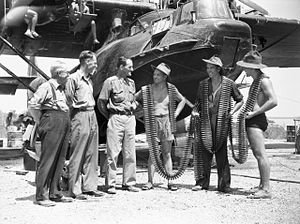
No. 75 Squadron is a Royal Australian Air Force (RAAF) fighter unit based at RAAF Base Tindal in the Northern Territory. The squadron was formed in 1942 and saw extensive action in the South West Pacific theatre of World War II, operating P-40 Kittyhawks. It was disbanded in 1948, but reformed the following year and operated jet aircraft throughout the Cold War. The squadron was based at Malta from 1952 to 1954, flying de Havilland Vampires, and Malaysia from 1968 to 1983, with Dassault Mirage IIIs, before returning to Australia.

No. 77 Squadron is a Royal Australian Air Force (RAAF) squadron headquartered at RAAF Base Williamtown, New South Wales. It is controlled by No. 81 Wing, and equipped with McDonnell Douglas F/A-18 Hornet multi-role fighters. The squadron was formed at RAAF Station Pearce, Western Australia, in March 1942 and saw action in the South West Pacific theatre of World War II, operating Curtis P-40 Kittyhawks. After the war, it re-equipped with North American P-51 Mustangs and deployed to Japan as part of the British Commonwealth Occupation Force. The squadron was about to return to Australia when the Korean War broke out in June 1950, after which it joined United Nations forces supporting South Korea. It converted from Mustangs to Gloster Meteor jets between April and July 1951 and remained in Korea until October 1954, claiming five MiG-15s and over five thousand buildings and vehicles destroyed during the war for the loss of almost sixty aircraft, mainly to ground fire.
No. 6 Squadron is a Royal Australian Air Force (RAAF) training and bomber squadron. It was formed in 1917 and served as a training unit based in England during World War I. The squadron was disbanded in 1919 but re-formed at the start of 1939. It subsequently saw combat as a light bomber and maritime patrol squadron during World War II, and took part in the New Guinea Campaign and New Britain Campaign before being disbanded after the war.
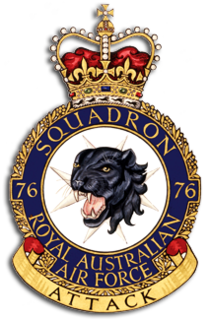
No. 76 Squadron is a Royal Australian Air Force (RAAF) flight training squadron. Established in 1942, it operated P-40 Kittyhawk fighter aircraft in the South West Pacific theatre during World War II. Following the end of hostilities it re-equipped with P-51 Mustangs and formed part of Australia's contribution to the occupation of Japan until disbanding in 1948. The squadron was re-formed in 1949 and three years later transferred to Malta, where it operated de Havilland Vampire jet fighters on garrison duty until again disbanding in 1955. It was reactivated in 1960 and operated CAC Sabre and Dassault Mirage III fighters in Australia until 1973. No. 76 Squadron was re-formed in its present incarnation in 1989 and is currently stationed at RAAF Base Williamtown, New South Wales, where it operates Hawk 127 jet training aircraft.
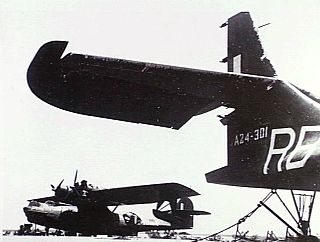
No. 42 Squadron was a Royal Australian Air Force (RAAF) mine laying and maritime patrol squadron of World War II. It was formed in June 1944 and conducted patrol and mine-laying operations over the Netherlands East Indies (NEI) from August 1944 until the war ended a year later, as well as operations in the waters off southern China in early 1945. Following the Japanese surrender, the squadron performed transport and reconnaissance flights until it was disbanded in November 1945.

No. 43 Squadron was a Royal Australian Air Force (RAAF) maritime patrol and mine-laying squadron that operated during World War II. Raised in early 1943, the squadron flew Catalina aircraft from bases in Queensland and the Northern Territory, flying mine-laying, convoy-protection and bombing sorties against Japanese targets in the Pacific theatre. These operations saw it operate as far north as the Chinese coast. After the conclusion of hostilities, the squadron was disbanded in mid-1946.

No. 14 Squadron was a Royal Australian Air Force maritime patrol squadron of World War II. It was formed in 1939 and was based in Western Australia throughout the war. While it conducted many patrols over the waters off Western Australia, it did not see combat. The squadron was disbanded in December 1945.

No. 12 Squadron was a Royal Australian Air Force (RAAF) general purpose, bomber and transport squadron. The squadron was formed in 1939 and saw combat in the South West Pacific theatre of World War II. From 1941 to 1943, it mainly conducted maritime patrols off northern Australia. The squadron was based at Merauke in western New Guinea from November 1943 to July 1944, when it was withdrawn from operations. After being re-equipped, it operated as a heavy bomber unit from February 1945 until the end of the war. The squadron continued in this role until it was redesignated No. 1 Squadron RAAF in February 1948. The squadron was reformed in 1973 to operate transport helicopters but was again disbanded in 1989.

No. 100 Squadron was a Royal Australian Air Force (RAAF) bomber and maritime patrol squadron that operated during World War II. Raised in early 1942 from the remnants of a British unit that had been destroyed in Malaya, the squadron flew Bristol Beauforts from bases in Queensland and New Guinea, undertaking torpedo- and level-bombing sorties against Japanese targets in the Pacific theatre. Following the conclusion of hostilities, the squadron was disbanded in August 1946.

No. 21 Squadron RAAF is a Royal Australian Air Force (RAAF) general reserve squadron. Formed in the mid-1930s as a unit of the part-time Citizen Air Force (CAF), it was mobilised for service during World War II, when it saw action against the Japanese as a fighter unit in the Malayan campaign, a dive bomber unit in the New Guinea campaign, and a heavy bomber unit in the Borneo campaign. After the war, the squadron continued to fly until 1960, when the CAF ceased flying operations. At that time, No. 21 Squadron converted to a non-flying support role, which it currently fulfils at RAAF Williams.

No. 22 Squadron is a Royal Australian Air Force (RAAF) mixed Permanent and Reserve squadron that provides support for the RAAF in the Sydney region. Formed in 1936, the squadron served in Papua New Guinea during the Second World War, and later followed the Pacific War as far as the Philippines. Following the war, the squadron was re-formed in 1948 but was converted to a non-flying support role in mid-1960. It is currently based at RAAF Base Richmond, New South Wales.
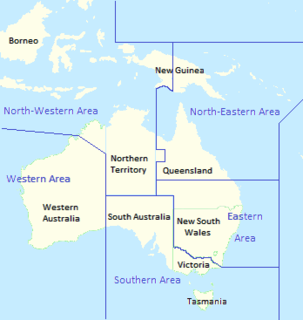
North-Eastern Area Command was one of several geographically based commands raised by the Royal Australian Air Force (RAAF) during World War II. For most of its existence it controlled units based in central and northern Queensland as well as Papua New Guinea. It was formed in January 1942 from the eastern part of the former Northern Area Command, which had covered all of northern Australia and Papua. Headquartered at Townsville, Queensland, North-Eastern Area Command's responsibilities included air defence, aerial reconnaissance and protection of the sea lanes within its territory. Its flying units, equipped with fighters, reconnaissance bombers, dive bombers and transports, took part in the battles of Rabaul, Port Moresby and Milne Bay in 1942, and the landings at Hollandia and Aitape in 1944.

No. 457 Squadron was a Royal Australian Air Force (RAAF) fighter squadron of World War II. Equipped with Supermarine Spitfire fighters, it was formed in England during June 1941 under Article XV of the Empire Air Training Scheme. The squadron was transferred to Australia in June 1942 and saw combat in the South West Pacific Area before being disbanded in November 1945.

No. 78 Squadron was a Royal Australian Air Force (RAAF) fighter squadron of World War II. It was formed in July 1943 as part of expansion of the RAAF's fighter force, and was assigned to mobile striking forces for the duration of the war.

No. 86 Squadron was a Royal Australian Air Force (RAAF) fighter squadron of World War II. The squadron was formed in March 1943 and was deployed to Merauke in Dutch New Guinea in July that year. While No. 86 Squadron was stationed at Merauke until April 1944, it saw little combat. After being transferred back to Australia its aircraft and personnel were transferred to other units, and only a nucleus of the squadron remained. While it was re-equipped with new aircraft in June 1945, the war ended before the squadron was ready for combat and it was disbanded in December 1945.
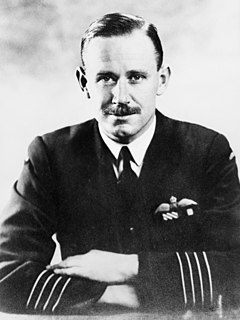
John Margrave Lerew, DFC was an officer and pilot in the Royal Australian Air Force (RAAF) during World War II, and later a senior manager in the International Civil Aviation Organization (ICAO). As commander of No. 24 Squadron, based in New Britain, he became famous in the annals of Air Force history for his irreverent response to orders by headquarters in Australia during the Battle of Rabaul in January 1942. After his squadron was directed to assist in repelling the invading Japanese fleet with its one serviceable bomber, and to keep its damaged airfield open, Lerew signalled headquarters with the ancient Latin phrase supposedly used by gladiators honouring their Emperor: "Morituri vos salutamus". He also defied an order to abandon his staff, and organised their escape from Rabaul.

No. 76 Wing was a Royal Australian Air Force (RAAF) wing that operated during World War II. Initially based in Far North Queensland, its headquarters transferred to Darwin, Northern Territory, in September 1944 to take control of three PBY Catalina units: Nos. 20, 42, and 43 Squadrons. The prime task of these squadrons was minelaying in the South West Pacific theatre, and they conducted these operations as far afield as Java, Borneo, the Philippines, and China. As well as minelaying, No. 76 Wing's Catalinas flew bombing, patrol, and transport missions, and dropped millions of propaganda leaflets in the closing months of the war. The wing headquarters disbanded in November 1945.

Western Area Command was one of several geographically based commands raised by the Royal Australian Air Force (RAAF) during World War II. It was formed in January 1941, and controlled RAAF units located in Western Australia. Headquartered in Perth, Western Area Command was responsible for air defence, aerial reconnaissance and protection of the sea lanes within its boundaries. Its aircraft conducted anti-submarine operations throughout the war, and attacked targets in the Dutch East Indies during the Borneo campaign in 1945.

North-Western Area Command was one of several geographically based commands raised by the Royal Australian Air Force (RAAF) during World War II. Its wartime sphere of operations included the Northern Territory, adjacent portions of Queensland and Western Australia, and the Dutch East Indies. The command was formed in January 1942, following the outbreak of the Pacific War, from the western part of Northern Area Command, which had covered all of northern Australia and Papua. Headquartered at Darwin, North-Western Area Command was initially responsible for air defence, aerial reconnaissance and protection of the sea lanes within its boundaries.
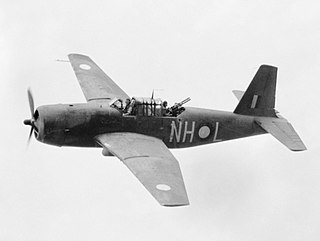
The Royal Australian Air Force (RAAF) operated Vultee Vengeance dive bombers during World War II. The Australian Government ordered 297 of the type in late 1941 as part of efforts to expand the RAAF. This order was later increased to 400 aircraft. A few Vengeances arrived in Australia during 1942, and large-scale deliveries commenced in early 1943; further orders were cancelled in 1944 after 342 had been delivered.
